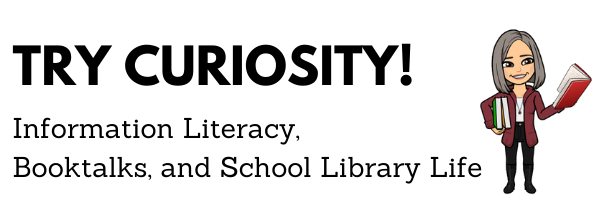This year, some teachers are planning to incorporate more STUDENT CHOICE (yay!) and more FICTION (yay!) into their content.
I put together book lists for two different 10th grade courses: English and History.
In grade 10 English, our students need to read either a historical fiction novel OR a memoir this month.
My challenge: Find and promote the best titles and get them into the hands of the students
Here's how I do it:
Step 1:
.JPG) |
| Piled up Historical Fiction and Memoirs |
Find the books
Our catalog does not consistently include genre as a subject heading, so although I start with a catalog search, I always end up reading the stacks to find the most titles.
I need to...
- pull books covering a range of historical time periods, both contemporary and classic
- pull memoirs appealing to a variety of interests such as personal tragedies, wartime, and multicultural
 - watch for a balance of reading levels
- watch for a balance of reading levels- watch for a balance of girl / boy appeal.
Step 2:
Create a Resource List in Destiny
After I pull all of the books, I enter them into a Resource List in our catalog. I also make sure each one's record includes "historical fiction" or "memoir" and any other genres that might help someone find the book again. The Resource List will stay in the catalog as long as I want - for the whole year or I can just highlight it during the unit.
.JPG) |
| Printed Resource List for Industrial Revolution/ Dystopia |
Step 3:
Promote the Resource List
I can print it with summary notes, copy/paste it into google docs (actually, I use Word first for best formatting and then upload into my Drive), and share it with the teachers. They now have digital copy for their curriculum planner (we use Atlas) for future reference.
Step 4:
Promote the books
I scour the web for book trailers and other resources to add to each record. I create a Pinterest board to share with students highlighting some of the most enticing covers with the call number in our library and a blurb.
 |
| A pin from our HS Memoir Pinterest board |
Step 5:
Book talks!
By the time classes come to the library, I know the books so well I can book talk them to drive up interest even more. When they come, I book talk by category and physically put each category in a different spot. For example, I'll zip through the historical fiction books that take place during the Holocaust, then the ones dealing with US History, and then the Ancient World. This way students can go right to the table that sounded most interesting instead of all clumping around one spot.
Step 6:
Follow up
.JPG) |
| Memoirs for EAL students |
I also invite students to post the covers of their favorites on our "Good Reads" board to help spread the word about which titles were popular. (More on this soon!)

Thanks for sharing your process. Mine is somewhat similar but I ne'er remember to promote it with the teachers. Great reminder.
ReplyDeleteI love the idea of using Pinterest! I troll other librarians pages all the time.
ReplyDelete